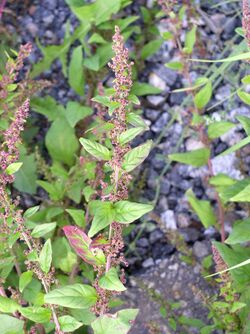Biology:Lipandra
| Lipandra | |
|---|---|

| |
| Manyseed goosefoot (Lipandra polysperma) | |
| Scientific classification | |
| Kingdom: | Plantae |
| Clade: | Tracheophytes |
| Clade: | Angiosperms |
| Clade: | Eudicots |
| Order: | Caryophyllales |
| Family: | Amaranthaceae |
| Subfamily: | Chenopodioideae |
| Tribe: | Atripliceae |
| Genus: | Lipandra Moq. |
| Species: | L. polysperma
|
| Binomial name | |
| Lipandra polysperma (L.) S. Fuentes, Uotila & Borsch
| |
| Synonyms | |
| |
Lipandra polysperma (Syn. Chenopodium polyspermum), common name manyseed goosefoot,[1] is the only species of the monotypic plant genus Lipandra from the subfamily Chenopodioideae of the family Amaranthaceae.
Description
Many-seeded goosefoot is a non-aromatic, glabrous annual herb, which can grow up to 1 m tall, although often has a sprawling habit. The stem is square in cross-section and can be green or bright red. The leaves (and subsequently branches) are alternate but sometimes nearly opposite at the base. it has no stipules. The petioles are up to 2.5 cm long, and the leaves are ovate-elliptic, 3-5 cm long, and usually have untoothed margins.[2][3]
The inflorescences consist of loose dichasia in the axils of leaf-like bracts, sometimes of more condensed glomerules of flowers arranged spicately. The flowers are bisexual or pistillate, with (4-) 5 nearly free perianth segments, 1-3 (-5) stamens and an ovary with 2 stigmas.
In fruit, perianth segments remain unchanged. The fruit has a membranous pericarp, which is free from the seed. The horizontally orientated seeds are compressed-globose. The brown to blackish seed coat is undulately striate.[4]
Distribution
Lipandra polysperma is distributed in most regions of Europe and in temperate Asia.[5] It is widely naturalized elsewhere, as in North America.[6]
Systematics
The species was first described in 1753 by Carl Linnaeus as Chenopodium polyspermum in Species Plantarum.[7] After phylogenetic research, Fuentes-Bazan et al. (2012) separated this species from genus Chenopodium that would otherwise have been polyphyletic. The genus Lipandra was first described by Alfred Moquin-Tandon in 1840 (in Chenopodearum monographica enumeratio, p. 19.), replacing an older illegitimate name: Christian Friedrich Lessing's genus Oligandra (1835, not the Asteraceae genus Oligandra from 1832) had only one species, Oligandra atriplicoides, that was soon considered identical with Chenopodium polyspermum.[4]
Lipandra polysperma belongs to the same tribe as Chenopodium, Tribus Atripliceae.[4]
Synonyms of genus Lipandra Moq.:[4]
- Oligandra Less. 1835 (nom illeg., non Less. 1832)
- Gandriloa Steud. (nom. illeg.)
- Oliganthera Endl. (nom. illeg.)
- Chenopodium [unranked] Polysperma Standl.
- Chenopodium subsect. Polysperma (Standl.) Kowal ex Mosyakin & Clemants
References
- ↑ "Chenopodium polyspermum". Natural Resources Conservation Service PLANTS Database. USDA. https://plants.usda.gov/core/profile?symbol=CHPO. Retrieved 16 January 2016.
- ↑ Sell, Peter; Murrell, Gina (2018). Flora of Great Britain and Ireland, vol 1. Cambridge: Cambridge University Press.
- ↑ Rose, Francis (2006). The Wild Flower Key. London: Frederick Warne. ISBN 978-0-7232-5175-0.
- ↑ 4.0 4.1 4.2 4.3 Fuentes-Bazan, Susy; Uotila, Pertti; Borsch, Thomas (2012). "A novel phylogeny-based generic classification for Chenopodium sensu lato, and a tribal rearrangement of Chenopodioideae (Chenopodiaceae)". Willdenowia - Annals of the Botanic Garden and Botanical Museum Berlin-Dahlem 42 (1): 14–15. doi:10.3372/wi42.42101. ISSN 0511-9618.
- ↑ {{citation | mode = cs1 | title = Lipandra polysperma | work = Germplasm Resources Information Network (GRIN) | url = https://npgsweb.ars-grin.gov/gringlobal/taxonomydetail.aspx?466035 | publisher = [[Organization:Agricultural Research ServAgricultural Research Service (ARS), United States Department of Agriculture (USDA) | access-date = 2013-07-10 }}
- ↑ Distribution map for the northern hemisphere from: Eric Hultén, Magnus Fries: Atlas of North European vascular plants. 1986, ISBN:3-87429-263-0 at Den virtuella floran..
- ↑ Carl von Linné: Species Plantarum. Vol. 1, Impensis Laurentii Salvii, Holmiae 1753, p. 220
External links
- Chenopodium polyspermum in Flora of North America
Wikidata ☰ {{{from}}} entry
 |

